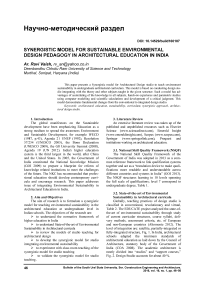Synergistic model for sustainable environmental design pedagogy in architectural education in India
Бесплатный доступ
This paper presents a Synergistic model for Architectural Design studio to teach environment sustainability in undergraduate architectural curriculum. This model is based on conducting design studio integrating with the theory and other subjects taught in the given semester. Such a model has advantages of assimilating of the knowledge in all subjects, hands-on experience and parametric studies using computer modelling and scientific calculations and development of a critical judgment. This model demonstrates fundamental changes from the conventional to integrated design studio.
Architectural education, sustainability, curriculum, synergistic approach, architectural design studio
Короткий адрес: https://sciup.org/147154447
IDR: 147154447 | УДК: 72.04(540) | DOI: 10.14529/build160107
Список литературы Synergistic model for sustainable environmental design pedagogy in architectural education in India
- Altomonte, S. (2012) Education for Sustainable Environmental Design,The EDUCATE Project available at https://ec.europa.eu/energy/intelligent/projects/sites/iee-projects/files/projects/documents/educate_education_for_sustainable_ environmental_design_en.pdf, accessed on 26.11.2015.
- COA (2008) Minimum standards of Architectural Education, Council of architecture (An statutory body of Govt. of India under the Architects Act, 1972), http://www.coa.gov.in, accessed on 26.11.2015.
- Cole, R. (1980) Teaching Experiments: Integrating Theory and Design, Journal of Architectural Education, vol. 33 (2).
- Davis H. (1982) Individual Houses in Groups: The Pattern Language in a teaching Studio, Journal of Architectural Education, vol. 36 (3), pp. 14-19.
- Dutton T. (1987) Design and Studio Pedagogy, Journal of Architectural Education, vol. 41 (1).
- G8 University Summit (2008) Sapporo Sustainability Declaration: The role of higher education for sustainability, Japan, http://www. engagement.illinois.edu/globalsummit2012/PDFs/All_Declarations.pdf, accessed on 23.11.2015.
- Gerlernter M. (1988) Reconciling Lectures and Studio, Journal of Architectural Education, Vol. 41 (2), 46-52.
- GOI (2009) National Knowledge Commission, Government of India, http://www.aicte-india.org/downloads/nkc.pdf, accessed on 26.11.2015.
- GOI (2013) National Skill Quality Framework, Gazette of India, Part 1, Section 2, Ministry of Finance Notification, Government of India, http://www.skilldevelopment.gov.in/nsqf.html, accessed on 24.11.2015.
- Goldschmidt G. (1983) Doing Design, Making Architecture, Journal of Architectural Education, vol. 37 (1), pp. 8-13.
- Heathcott J. (2007) Improving Doctoral Education in the Humanities, Change, October, 47-51.
- Ledewitz S. (1985) Models of Design in Studio Teaching, Journal of Architectural Education, vol. 38 (2): pp. 2-8.
- Robinson J and Weeks S. (1983) Programming as Design, Journal of Architectural Education, vol. 37(2).
- Salama A.M. (1995) New Trends in Architectural Education: Designing the Design Studio, ARTI-ARCH.
- Salama A.M. and Wilkinson N. (editors) (2007) Design Studio Pedagogy: Horizons for the Future, The Urban International Press, Gateshead, Tyne and Wear, United Kingdom.
- Sanoff H. (1978) Designing with Community Participatoin, Dowden, Hutchinson, and Ross, Stroudsburg, PA.
- Simons G. (1978) Analogy in Design: Studio Teaching Models, Journal of Architectural Education, vol. 31(3).
- Svoboda, S. and J. Whalen (2004/5) Using Experiential Simulation to Teach Sustainability, Greener Management International, pp. 57-65.
- Symes M. and Marmot A. (1985) The Social Context of Design: A Case Problem Approach, Journal of Architectural Education, 38 (4).
- Szokoloy S.V. (2008) Introduction to Architectural Science: The Basis of Sustainable Design, Routledge.
- Truscheit A. and C. Otte (2004) Sustainable Games People Play: Teaching Sustainability Skills with the Aid of the Role-Play, Nord West Power, Greener Management International, pp. 51-56.
- UN (2012)The Future We Want, United Nations Conference on Sustainable Development (Rio+20), http://www.uncsd2012.org/thefuturewewant. html accessed on 26.11.2015.
- UNEP (1992) Agenda 21: Promoting Education, Public Awareness, and Training (Chapter 36); Millennium Development Goals, United Nations Conference on Environment and Development (Earth Summit), http://www.unep.org/documents. multilingual/default.asp?DocumentID=52&ArticleID=4415&l= en, accessed on 26.11.2015.
- UNESCO (2005) Education for Sustainable Development, United Nations Educational, Scientific and Cultural Organization, http://www.unesco. org/new/en/education/themes/leading-the-international-agenda/education-for-sustainable-development/mission/accessed on 26.11.2015.
- UNESCO (2009) Bonn Declaration, World conference on Education for Sustainable Development, 31 March -2 April, Bonn, Germany, United Nations Educational, Scientific and Cultural Organization and Federal Ministry of Education and Research, http://www.esd-world-conference-2009.org/fileadmin/download/ESD2009_BonnDeclaration080409.pdf, accessed on 10.8.2012.
- WCED (1987) Our Common Future, World Commission on Environment and Development, Oxford University Press, London, http://www.un-documents. net/our-common-future.pdf, accessed on 26.11.2015.


